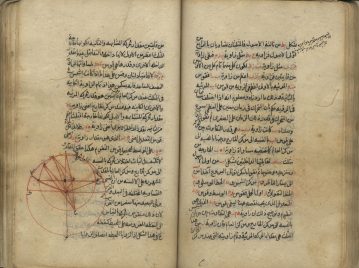[Thirteen Epistles]. Rasail Shaykh Bahaii.
Al-Amili, Baha'al-Din Muhammad (1547-1621) / Arabic Manuscript.
Synopsis
Texts include geometry, religion, finding the direction of Mecca mathematically, when to prostrate one self in the reading of the Qur’an, astronomy, arithmetic, chemistry, and the uniqueness of Allah.
Shaykh Baha’ al-Din contributed numerous works in philosophy, logic, astronomy and mathematics. His works include over 100 articles, epistles and books. He also composed poems in Persian. His outstanding works in the Persian language are Jame’ Abbasi and two masnavis (rhymed couplets) by the names of “Milk and Sugar” and “Bread and Halva”. His other important work is the Kashkool, which includes stories, news, scientific topics, Persian and Arabic proverbs.
Al-Amili was an expert on a wide range of subjects such as theology, philosophy, law, and mathematics. He was famed as a poet, a grammarian and an architect. Perhaps his most famous mathematical work was Quintessence of Calculation which was a treatise in ten sections, strongly influenced by The Key to Arithmetic (1427) by Jamshid al-Kashi.
Rofagha writes :
The study concludes the following: First, ‘Quintessence of Calculation’ was a highly influential mathematics textbook in Central Asia between the 17th century and the beginning of the 20th century. Its influence was partly due to the soundness of its mathematical algorithms resulting from Sheikh Bahai’s mastery of mathematics, especially the one enhanced by al-Kashi, a celebrated mathematician in the 15th century. The study provides evidence that Sheikh Bahai studied al-Kashi’s work. By utilizing these algorithms, Sheikh Bahai made the highly practical aspects of seven centuries of Islamic-culture mathematical achievements available to the region at large. Furthermore, the study concludes that the remarkable influence of ‘Quintessence of Calculation’ can be attributed to the specific approaches of Sheikh Bahai’s presentations of mathematical concepts and algorithms. His approaches are identified as a result of detailed analytical comparison between this book and a major book of al-Kashi. The study also provides a partial answer to the creativity of Sheikh Bahai that enabled him to author several educational books, including ‘Quintessence of Calculation’, which were highly influential for several centuries. Subsequently, the study identifies Sheikh Bahai’s method of discovery, which was also practiced by Avicenna (ibn Sina), a distinguished mathematician and scientist in the 11th century; this method is introduced and examined through a contemporary hypothesis presented by Elahi.
Other works on astronomy included: The Flat Surface, a work on the astrolabe; A Treatise on Astronomy; and, his most important astronomical work The Anatomy of the Heavens, a treatise in five sections which summarised the works of earlier authors. Among al-Amili’s works on grammar we mention: The Secrets of Eloquence; All Eternal Directives respecting the Science of Arabic Grammar; and The Elevated Words, also an Arabic grammar. Among his religious works are: The Forty Hadith Compilation, an annotated compilation of forty traditions ascribed to the prophet Muhammad; The Orchards of Veracity in Commentary upon the Sahifa al-sajjadiyya; On the Science of Hadith-Tradition; Treatise on the Pilgrimage; Treatise on Fasting; Treatise on the Law of Obligatory Prayer; and Treatise on the Law of Ritual Prostration. Some of these works, as is evident from their titles, also consider legal aspects of religion. His other legal works include: The Dawning Place of the Two Suns and the Elixir of Twofold Felicity; Issues in Jurisprudence; The Treatise on Establishment of the Doctrines of the Shi’a, the legalistic aspects and the doctrinal fundamentals; Essence of the Foundations of Jurisprudence; and Treatise on the Determination of the Qibla. He was also famed as a poet writing: On the Secrets of the Mightiest Name of God; Bread and Halva, which describes the experiences of an itinerant holy man and this could well be autobiographical describing his own Mecca pilgrimage; Bread and Cheese; Mouse and Cat; Milk and Sugar; and The Parrot, containing 2500 verses.
An interesting discovery was made comparatively recently in Isfahan when the house in which al-Amili lived was identified. It has been restored and a conducted tour of the house is available on the web.






